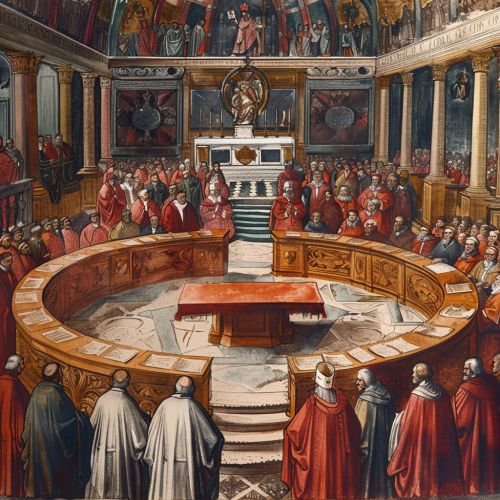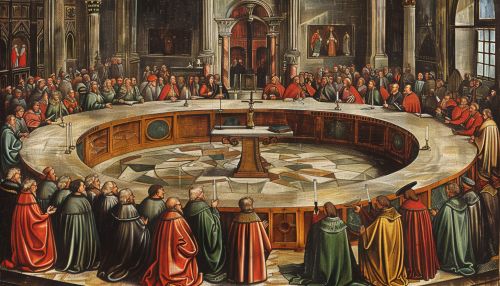Counter-Reformation
Introduction
The Counter-Reformation, also known as the Catholic Reformation or the Catholic Revival, was a period of Catholic resurgence initiated in response to the Protestant Reformation. It began with the Council of Trent (1545–1563) and ended at the close of the Thirty Years' War (1648). The Counter-Reformation was a comprehensive effort to reform the Catholic Church from within and to counteract the growth of Protestantism across Europe.
Historical Context
The Protestant Reformation, initiated by Martin Luther's Ninety-Five Theses in 1517, challenged the doctrines, practices, and ecclesiastical structure of the Roman Catholic Church. The rapid spread of Protestant ideas threatened the unity and authority of the Catholic Church. In response, the Catholic Church embarked on a series of reforms to address internal corruption, reaffirm core doctrines, and reassert its spiritual and political influence.
Council of Trent
The Council of Trent was the cornerstone of the Counter-Reformation. Convened by Pope Paul III, the council met in three sessions between 1545 and 1563. It aimed to address doctrinal and disciplinary issues within the Church. Key outcomes included the reaffirmation of traditional Catholic teachings, the establishment of seminaries for the proper training of priests, and the standardization of the Mass and other liturgical practices.


Doctrinal Reaffirmations
The Council of Trent reaffirmed several key Catholic doctrines that had been challenged by Protestant reformers. These included the authority of the Pope, the necessity of both faith and works for salvation, the seven sacraments, the doctrine of transubstantiation, and the veneration of saints and relics. The council also issued decrees on the importance of the Latin Vulgate Bible and the necessity of maintaining clerical celibacy.
Disciplinary Reforms
To address widespread corruption and abuses within the Church, the Council of Trent implemented several disciplinary reforms. These included the establishment of seminaries for the education and training of priests, the requirement for bishops to reside in their dioceses, and the enforcement of clerical celibacy. The council also sought to improve the moral and spiritual conduct of the clergy and laity through stricter enforcement of ecclesiastical discipline.
The Jesuits and Other Religious Orders
The Society of Jesus, commonly known as the Jesuits, played a crucial role in the Counter-Reformation. Founded by Ignatius of Loyola in 1540, the Jesuits were dedicated to the renewal of the Catholic Church through education, missionary work, and the promotion of religious and moral discipline. The Jesuits established schools, colleges, and universities across Europe and beyond, becoming influential in both religious and secular education.
Other religious orders, such as the Capuchins, Theatines, and Ursulines, also contributed to the Counter-Reformation by focusing on pastoral care, education, and missionary activities. These orders emphasized personal piety, poverty, and obedience, serving as models of reform and renewal within the Church.
The Roman Inquisition and the Index of Forbidden Books
The Roman Inquisition, established in 1542, was a key instrument of the Counter-Reformation. It aimed to combat heresy and enforce doctrinal conformity within the Catholic Church. The Inquisition conducted trials, issued censures, and imposed penalties on individuals accused of heretical beliefs or practices. The Index Librorum Prohibitorum, or Index of Forbidden Books, was a list of publications deemed heretical or contrary to Catholic doctrine. The Index sought to control the spread of Protestant and other non-Catholic ideas by banning the reading and distribution of certain books.
Art and Architecture
The Counter-Reformation had a significant impact on art and architecture, leading to the development of the Baroque style. Baroque art and architecture were characterized by dramatic, emotional, and ornate elements designed to inspire awe and devotion. Churches and religious buildings were adorned with elaborate frescoes, sculptures, and altarpieces that depicted religious themes and conveyed the glory and majesty of the Catholic faith.
Prominent artists of the Counter-Reformation period included Caravaggio, Peter Paul Rubens, and Gian Lorenzo Bernini. Their works emphasized realism, emotional intensity, and the use of light and shadow to create dramatic effects. Baroque architecture, exemplified by structures such as St. Peter's Basilica in Rome, featured grandiose designs, intricate details, and a sense of movement and dynamism.
Education and Catechesis
Education and catechesis were central to the Counter-Reformation's efforts to strengthen the Catholic faith and counteract Protestant influence. The establishment of seminaries ensured the proper training of priests, while the creation of catechisms provided clear and concise summaries of Catholic doctrine for the laity. The Roman Catechism, published in 1566, became a standard reference for teaching Catholic beliefs and practices.
The Jesuits and other religious orders played a vital role in promoting education at all levels. They founded schools, colleges, and universities that provided a rigorous education in both religious and secular subjects. These institutions became centers of learning and intellectual activity, contributing to the renewal and revitalization of the Catholic Church.
Missionary Activities
The Counter-Reformation also saw a renewed emphasis on missionary activities, both within Europe and in newly discovered territories. Catholic missionaries, including Jesuits, Franciscans, and Dominicans, traveled to Asia, Africa, and the Americas to spread the Catholic faith and convert indigenous populations. These missionaries established missions, schools, and churches, often working in challenging and hostile environments.
Prominent missionaries of the Counter-Reformation period included Francis Xavier, who evangelized in India, Japan, and Southeast Asia, and Matteo Ricci, who worked in China. Their efforts contributed to the global spread of Catholicism and the establishment of a Catholic presence in diverse cultural contexts.
The Role of Women
Women played a significant role in the Counter-Reformation, both as members of religious orders and as lay participants in the renewal of the Catholic Church. Female religious orders, such as the Ursulines and the Discalced Carmelites, focused on education, charitable work, and contemplative prayer. These orders provided opportunities for women to engage in religious and social activities, contributing to the spiritual and moral renewal of the Church.
Prominent female figures of the Counter-Reformation included Teresa of Ávila, a Spanish mystic and reformer who founded the Discalced Carmelites, and Angela Merici, the founder of the Ursulines. Their writings and actions inspired many and played a crucial role in the spiritual revival of the period.
Political and Social Impact
The Counter-Reformation had significant political and social implications, as the Catholic Church sought to reassert its influence in a rapidly changing world. The period saw the rise of Catholic monarchs and states that supported the Church's efforts to combat Protestantism and enforce religious conformity. The Habsburg dynasty, for example, was a staunch supporter of the Counter-Reformation, using its political power to promote Catholicism in its territories.
The Counter-Reformation also contributed to the development of the modern state, as rulers sought to centralize authority and enforce religious uniformity. This period saw the emergence of state-controlled churches and the use of religious policy as a tool of governance. The efforts to enforce religious conformity often led to conflicts and tensions, culminating in events such as the Thirty Years' War, which had profound and lasting effects on European society.
Legacy
The Counter-Reformation left a lasting legacy on the Catholic Church and European society. It resulted in significant reforms within the Church, including the establishment of seminaries, the standardization of liturgical practices, and the reaffirmation of key doctrines. The period also saw the rise of influential religious orders, the spread of Catholicism through missionary activities, and the development of Baroque art and architecture.
The Counter-Reformation's emphasis on education, catechesis, and pastoral care contributed to the renewal and revitalization of the Catholic faith. While the efforts to combat Protestantism were not entirely successful, the Counter-Reformation played a crucial role in shaping the modern Catholic Church and its role in the world.
